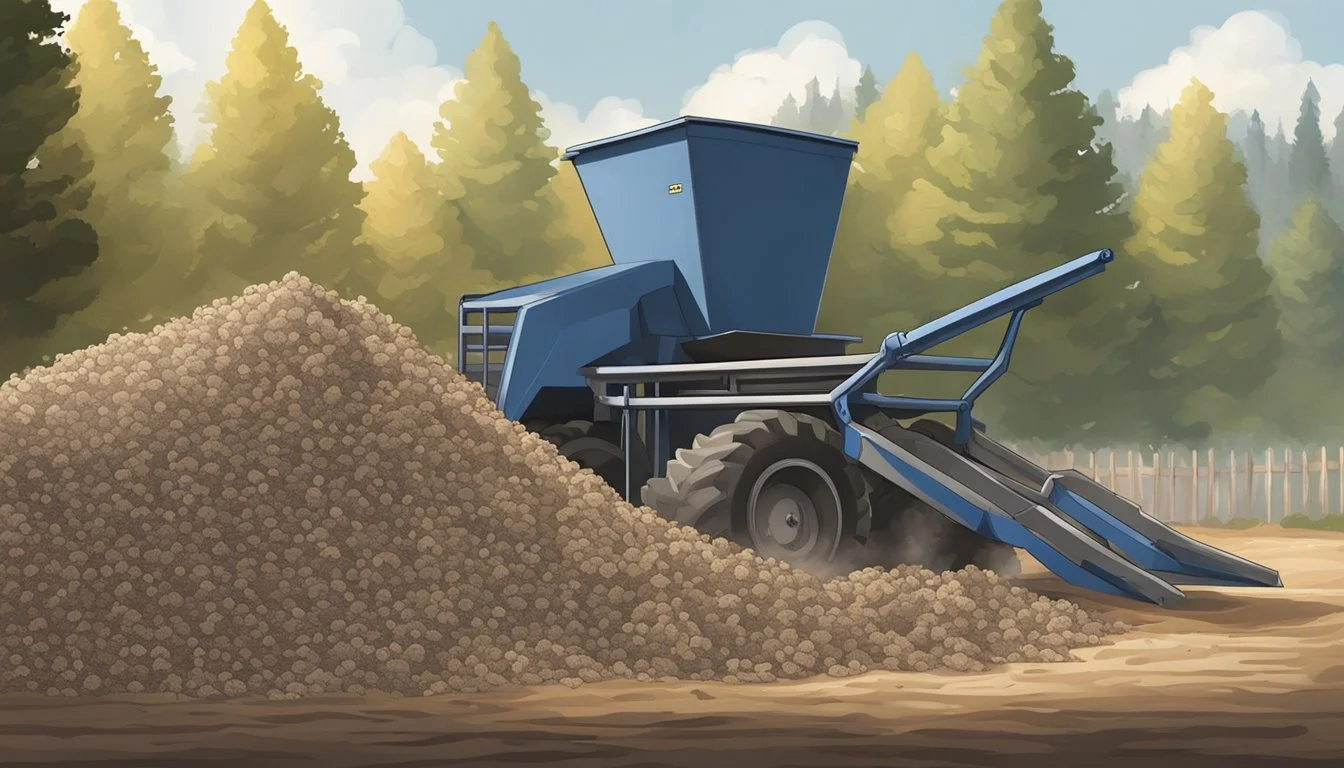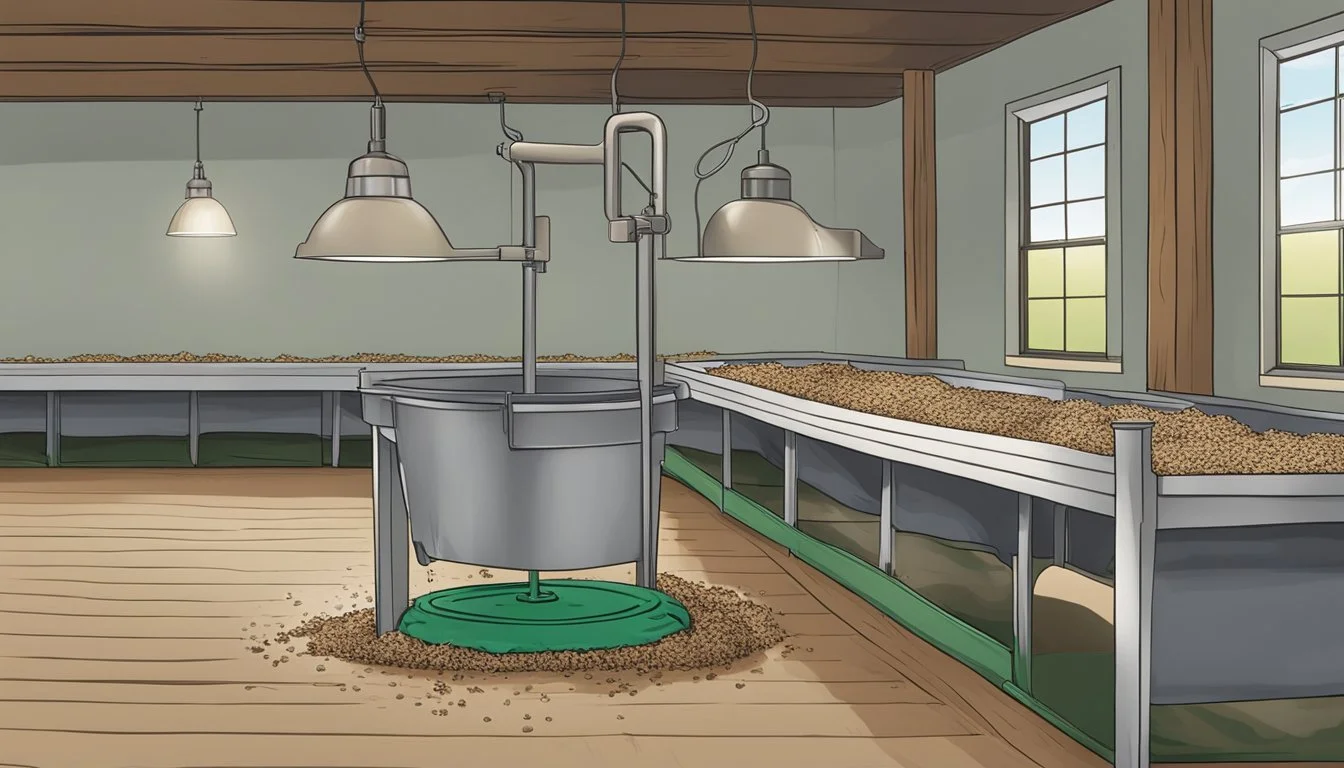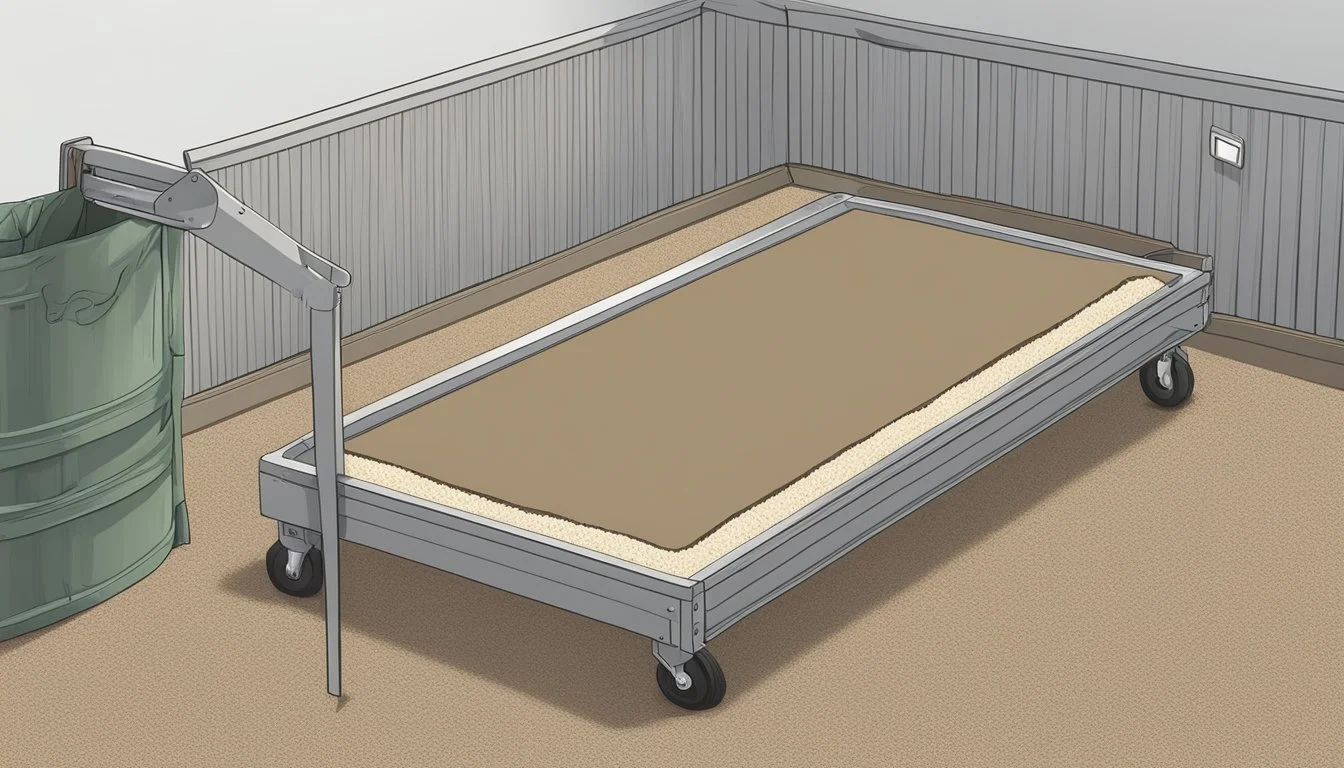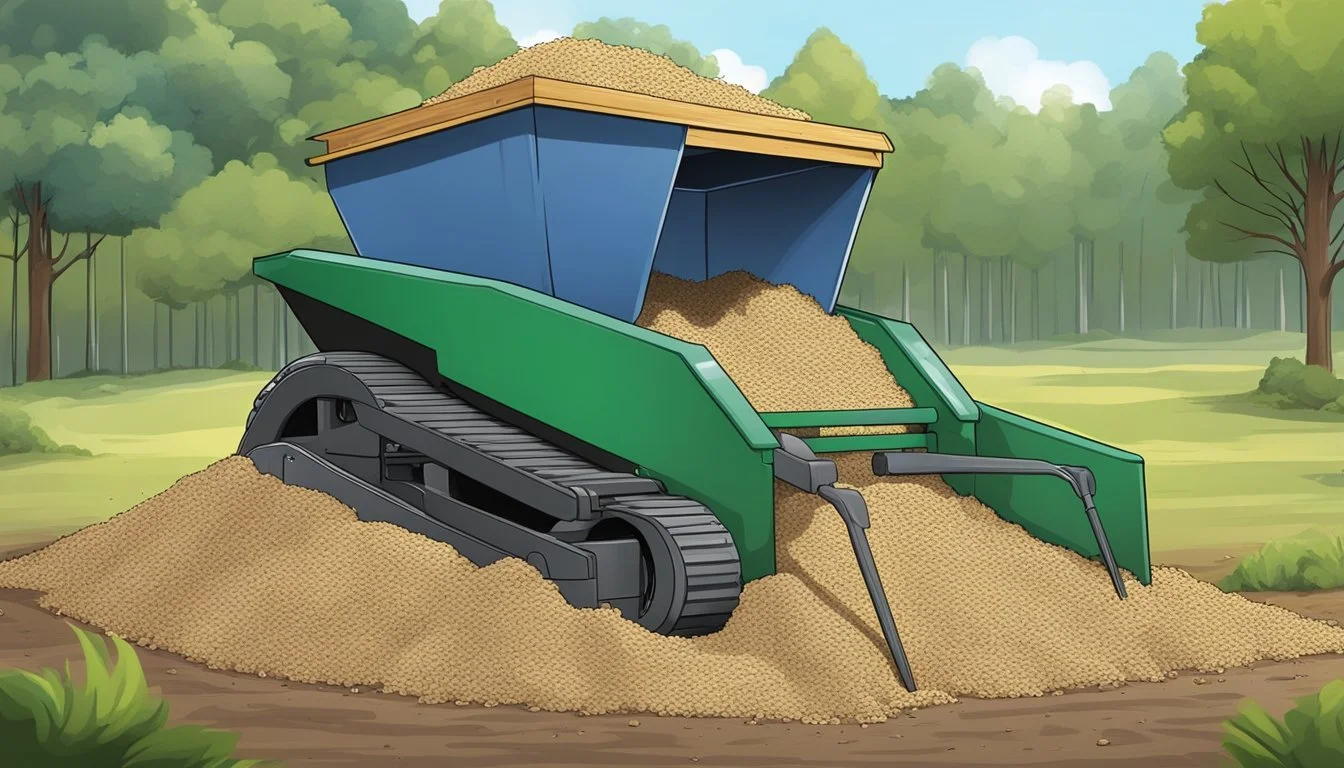The Ultimate Guide to Using a Stall Fork
Streamline Your Homestead's Animal Bedding Maintenance
Maintaining a clean and healthy environment for animals is critical for homesteaders who keep horses or other livestock. Efficient cleaning of animal bedding is not just about tidiness; it's about ensuring the well-being of the animals and the ease of daily tasks. The stall fork, with its specialized design, is an indispensable tool for homesteaders. It allows for the effective removal of manure and soiled bedding while preserving the clean bedding, making the process more economical and environmentally friendly.
Key to optimizing the use of a stall fork is understanding the various techniques that can save both time and bedding materials. Using a stall fork correctly involves more than just scooping up waste; it requires a methodical approach to sifting through the bedding, separating waste from clean material with minimal effort. Regular cleaning with a stall fork not only keeps stalls fresh but also prevents the build-up of harmful ammonia gases and potential pests.
The design of the stall fork itself, usually featuring a multi-pronged head, aids in targeting specific areas within a horse stall. The technique involves gently shaking the fork to sift through soiled bedding, allowing the clean particles to fall through the tines. Certain movements and strategies can further enhance the efficiency of cleaning; for instance, swift side-to-side motions can separate clean bedding from manure more effectively than vertical sifting. With an understanding of these methods, homesteaders can ensure that their stall cleaning practices are both thorough and resourceful.
Understanding Stall Bedding Essentials
Choosing the right stall bedding and flooring is crucial for the health and comfort of your animals. These elements ensure clean living conditions and contribute to efficient stall maintenance.
Evaluating Bedding Materials
Different types of bedding materials serve various functions within an animal stall. The most commonly used materials include:
Straw Bedding: Often used for its affordability, straw bedding provides a soft and comfortable layer. However, it can be less absorbent than other materials and may need to be changed more frequently to maintain a dry environment.
Wood Shavings: Wood shavings are highly absorbent and help to control odors. They must be chosen carefully as some woods can be harmful to animals if ingested.
Pelleted Bedding: Made from compressed wood, pelleted bedding is super-absorbent and expands when exposed to moisture, creating a manageable, dense bedding option.
Choosing suitable fresh bedding depends on factors such as absorbency, dust levels, and ease of cleaning. It's essential to select bedding that keeps the stall dry and is easy to sift through when removing waste with a stall fork.
Selecting the Right Mats and Flooring
Proper mats and flooring under the bedding are vital for an animal's comfort and stall hygiene. There are two primary flooring options:
Rubber Mats: These provide a cushioned, non-slip surface that is easy to clean and install. Rubber mats reduce the amount of bedding needed and are gentle on an animal's joints.
Concrete Flooring: Though durable and easy to clean, concrete flooring must be covered with ample bedding to prevent sores and provide warmth, as it does not offer the same cushioning as rubber mats.
When adding stall mats, it is important to choose ones that fit snugly to prevent shifting and to ensure all areas of the stall are covered to optimize the living conditions for the animal.
Developing an Efficient Stall Cleaning Routine
An efficient stall cleaning routine hinges on adhering to a strict cleaning schedule and mastering a step-by-step mucking out process.
Identifying Key Cleaning Times
Determining the optimal cleaning times is crucial for maintaining a hygienic environment for animals. A suggested cleaning schedule would typically involve mucking out stalls twice a day—once in the morning and once in the evening. This frequency keeps the bedding fresh and prevents the build-up of waste and bacteria.
Step-by-Step Stall Mucking Process
To methodically clean stalls, one begins by segregating clean bedding from soiled. Using a stall fork, they methodically sift through the bedding, moving clean materials to one side.
Remove all manure and wet spots.
Rake the bedding towards the center to expose the floor.
With clean bedding aside, remove the muck using a wheelbarrow or muck bucket.
Sprinkle stall freshener if needed, ensuring the area remains dry.
Return the clean bedding to its place, spreading evenly.
By following these steps, a stall cleaning routine becomes both systematic and efficient, establishing a clean, comfortable environment for the animals.
The Proper Use of Cleaning Tools
Having the right tools and knowing how to use them makes stall cleaning more efficient and less demanding. The proper use of a manure fork and transportation aids like wheelbarrows and carts is critical.
Choosing the Right Manure Fork
The selection of a manure fork is crucial for efficient stall cleaning. A durable manure fork with a comfortable grip can make the task quicker and reduce strain on the user.
Key characteristics to consider:
Tine Durability: Strong tines resist breaking and allow for repeated use.
Tine Spacing: Spaces should be small enough to sift out debris while leaving behind clean bedding.
Weight: A lightweight fork decreases the effort required for long periods of stall mucking.
Ergonomics: An ergonomic handle helps prevent fatigue and allows for a better hand position.
Effective Use of Wheelbarrows and Carts
Transporting soiled bedding and manure out of the stall efficiently often requires a wheelbarrow or a cart.
Wheelbarrows: Ideal for navigating narrow barn aisles or uneven terrain, they should be sturdy, with well-inflated tires for easy maneuverability.
Preferred wheelbarrow features include:
Capacity: Must be large enough to contain debris but not too heavy when full.
Durability: Should be constructed from high-quality materials to withstand the weight and abrasiveness of manure and bedding.
Handles: Ergonomically designed for a comfortable grip and effective load distribution.
Carts: They are preferable for larger volumes or longer distances since they can be attached to a tractor or ATV.
Optimal cart attributes:
Size: Large enough to handle the amount of waste typically produced in one cleaning.
Wheels: Equipped with heavy-duty wheels suitable for the terrain and weight of the load.
Handle: Should come with a robust handle to assist in manual pulling where necessary.
Incorporating scooping tools like shovels and rakes can further expedite the cleaning process, allowing for easy collection of waste from the bedding. Additionally, cleaning tools such as brooms are essential for maintaining tidy aisles after stall mucking is completed. A bucket is often used to provide a convenient way to transport smaller amounts of waste or to hold cleaning tools. A leaf rake may be used to gather and remove loose debris from around the stall. All tools should be kept clean and in good repair to ensure they last longer and function properly.
Manure and Wet Spot Removal Techniques
Effectively removing manure and wet spots from animal bedding ensures a clean and hygienic environment for livestock. Key techniques include careful segregation of waste and use of appropriate tools for disposal.
Segregating Solid and Liquid Waste
To maintain a clean stall, it is critical to separate solid manure and urine-soaked bedding. This process not only preserves the remaining clean bedding but also aids in manure management.
Identifying Wet Spots: Detect wet spots by looking for darker, discolored areas in the bedding. These areas are typically where urine has soaked into the shavings or other bedding material.
Tools: Utilize a stall fork designed to sift through the bedding, allowing for the separation of usable bedding from the soiled shavings.
Action: Pick up the manure with the fork and discard it directly into a muck bucket or wheelbarrow.
Removing Wet Bedding: Once the manure is removed, focus on the wet bedding.
Tools: A shovel can be useful to scoop up urine-soaked areas that are too heavy or clumped for the stall fork.
Action: Scoop these soiled shavings into the muck bucket or wheelbarrow.
Bedding Disposal: After segregation, transporting the waste to an appropriate disposal site is essential.
Manure Disposal: Transport the manure to a designated compost pile or manure management system.
Composting: Consider composting the organic waste to convert it into nutrient-rich fertilizer, a beneficial process for the homestead's soil.
Bedding Management Post-Removal:
Unused Bedding: Ensure that any clean and dry shavings left in the stall are spread evenly, allowing them to continue absorbing moisture.
Drying: If possible, allow the stall to air out briefly before adding fresh bedding, which aids in maintaining a dry and comfortable environment.
By following these targeted strategies for manure and wet spot removal, the stall hygiene can be kept at an optimal level, contributing to the overall welfare of the animals.
Maintaining a Healthy Stall Environment
A healthy stall environment is paramount for the well-being of animals. It hinges on consistent disinfection, sanitation, and proper air quality. Implementing a regular cleaning protocol ensures a safe, disease-free habitat.
Daily Disinfecting and Sanitation
Disinfecting - One should select an appropriate disinfectant that is safe for animals and effective against a broad spectrum of pathogens. Daily cleaning routines must include thoroughly disinfecting surfaces that come into contact with the animal. This includes stall walls, water buckets, and feeding troughs.
Steps:
Remove all bedding: Clear the stall of all bedding using a stall fork.
Apply disinfectant: Spray chosen disinfectant according to manufacturer instructions.
Allow to dry: Before reintroducing bedding, ensure surfaces are completely dry to prevent respiratory issues.
Sanitation - Daily mucking out is crucial. One should remove feces and urine-soaked bedding to prevent the buildup of ammonia, which can cause respiratory problems.
Key Items to Address:
Manure: Immediate removal reduces flies and odors.
Wet Spots: Identify and remove areas soaked with urine to prevent hock sores.
Cobwebs and Dust: Regularly clean to decrease fire hazards and improve air quality.
Enhancing Air Quality and Ventilation
Ventilation - Providing adequate ventilation is essential to dispel odors and reduce the accumulation of harmful gases. Implementing strategic airflow can prevent the onset of respiratory problems.
Strategies:
Open Windows/Doors: To promote cross-ventilation.
Fans: May be installed to increase air circulation.
Air Quality - Maintaining a dust-free environment is crucial. Dust and mold in the bedding can severely affect animals' respiratory systems.
Suggested Practices:
Regularly Replace Bedding: Use low-dust bedding materials and change them before they break down into fine particles.
Manage Bedding Moisture: Keep bedding dry to inhibit mold growth.
Deep Cleaning Strategies
An effective deep clean is essential for maintaining a healthy environment for animals in a homestead. It involves thorough cleaning of the stall, removal of all bedding, and disinfection to create a sanitary space that can then be replenished with new bedding.
When and How to Perform a Deep Clean
A deep clean should be performed regularly, depending on the number of animals and the rate of bedding soiling. At a minimum, a monthly deep clean is recommended; for more heavy use, bi-weekly may be necessary. One starts by removing all animals from the area. Then, using a stall fork, meticulously remove all bedding material.
Next, the cleaning should continue by:
Sweeping any remaining debris.
Using a pressure washer or a hose with a high-pressure nozzle to wash down all surfaces.
Applying a stall freshener where applicable to neutralize odors and reduce the presence of pests.
Following with a disinfectant, one should thoroughly spray surfaces, focusing on corners and any hard-to-reach areas where pathogens might linger.
Replenishing Bedding After Cleaning
Once the stall is dry and free from disinfectant fumes, it's time to replenish with new bedding. It's critical to ensure that any moisture has been completely eradicated before new bedding is added to prevent the growth of mold and bacteria. The type of bedding used will depend on the animals' needs, availability, and the homesteader's preference.
Proper layering is as follows:
Start with a base layer that's absorbent, such as pine pellets or shavings.
Add comfortable padding on top, like straw or larger shavings for animals to rest on.
It is also advisable to spot check daily, removing soiled spots to extend the life of the bedding between deep cleanings.
Post-Cleaning Maintenance and Care
After efficiently cleaning animal bedding with a stall fork, the homesteader must not overlook the significance of post-cleaning maintenance and care. This is crucial for ensuring the longevity of the bedding materials and the overall health of the animals.
Routine Care for Bedding and Mats
Regular care for bedding involves a systematic approach to maintain cleanliness and comfort for the animals. Homesteaders should:
Air out the bedding: Allow it to dry completely, which prevents the proliferation of bacteria and parasites.
Rotate and fluff the bedding: This action ensures an even wearing of the material and precludes the formation of damp spots.
Stall mats need attention, too. They should be:
Lifted and cleaned underneath: Do this periodically to prevent accumulation of waste and moisture that can damage the barn flooring.
Hosed off with water and a mild detergent and allowed to air dry: This practice is essential to maintain a hygienic environment.
Regular Inspection for Stall Damage
Inspecting the stall itself is an integral aspect of maintenance. During routine checks, one should:
Check for physical damages: Look for any tears, cracks, or breaks in mats and repair or replace them as needed to ensure a safe environment for the animals.
Utilize stall fresheners: These can help neutralize odors and extend the life of bedding material, keeping the stall pleasant for both animals and caretakers.
Regular inspection and maintenance of stalls are essential for preventing unnecessary costs from damages and for providing a clean and safe space for the animals. Homesteaders should establish a scheduled maintenance routine to remain proactive in the care of their stalls.
Animal-Specific Considerations
When cleaning animal bedding, one must adjust the technique based on the type of animal and their unique needs. Stall forks are versatile but using them effectively involves understanding these nuances.
Adjustments for Different Horse Types
Cleaning horse stalls requires different approaches depending on whether the horse is a stallion, mare, or gelding. Stallions often require more frequent bedding changes due to stronger urine and a tendency to mark territory. Mares, especially when in heat, may also affect how soiled the bedding becomes. Geldings generally have more consistent bedding maintenance needs, but individual behavior can vary the required cleaning frequency and method.
Stallions: Daily cleaning to manage strong odors and marking behavior.
Mares: Monitor for changes when in heat; may necessitate additional cleaning.
Geldings: Typically require standard cleaning schedules unless behavioral factors arise.
Managing Bedding for Other Farm Animals
Other farm animals such as cows, goats, and sheep also require bedding management, but the material and cleaning frequency may differ from horses. Using a stall fork for animals like goats, which might prefer hay bedding, involves carefully removing soiled areas while preserving as much clean hay as possible. For all animals, it's crucial to maintain a dry environment to prevent diseases and promote comfort.
Goats/Sheep: They often prefer hay bedding; focus on removing moist spots while conserving dry hay.
Dairy Cows: Typically require larger amounts of bedding; prioritize cleanliness to maintain udder health.
Advanced Topics in Stall Bedding and Cleaning
Maintaining a clean environment in animal stalls is crucial, and leveraging advanced equipment, as well as understanding the impact of right bedding choices, can enhance animal welfare and cleaning efficiency.
Innovative Cleaning Equipment and Supplies
When it comes to stall cleaning tools, investing in the right equipment is essential for efficiency. The Shake'n Fork is an example of an advanced tool available on the market, typically found on platforms like Amazon. This motorized manure fork vibrates to sift through bedding, allowing clean bedding to fall back into place while retaining waste, which can be significant in reducing bedding costs and labor.
Cleaning Supplies Checklist:
Motorized manure forks (e.g., Shake'n Fork)
High-quality muck buckets or wheelbarrows
Stiff bristled brushes for scrubbing
Disinfectant solutions specifically designed for animal stalls
These supplies not only streamline the process but also contribute to a more thorough clean, ensuring the removal of damp or dirty bedding that can harbor pathogens.
The Role of Bedding in Preventing Hock Sores
Bedding plays a pivotal role in safeguarding the animal's health, especially in preventing hock sores. The standard for stall bedding should strike a balance between comfort and absorbency. Providing a soft bedding layer helps protect the animal's hocks from hard surfaces, reducing the risk of sores.
Preventative Bedding Strategies:
Use a sufficiently deep layer of high-absorbency bedding (such as straw, shavings, or pelleted bedding).
Regularly remove wet spots and manure to keep the bedding dry and clean.
Consider adding rubber matting beneath the bedding to ease the pressure on the animal's hocks.
By focusing on these advanced topics, one can substantially improve the standard practices around stall bedding and cleaning, leading to a healthier living space for animals and more efficient maintenance routines.
Environmental Impact and Sustainability
Using a stall fork effectively in cleaning animal bedding has direct benefits for both the environment and the overall sustainability of a homestead. The practices deployed for handling manure and used bedding can significantly lower the environmental footprint of animal care activities.
Best Practices for Manure and Bedding Disposal
Composting: Transforming manure and bedding into compost is a highly sustainable practice. It not only reduces waste going to the landfill but also harnesses nutrients for soil enrichment. Homesteaders should be diligent in establishing a compost pile where manure and used bedding can decompose over time.
Site Selection:
Choose a well-drained area for your compost pile.
Ensure the site is convenient for adding new materials and for later use of the compost.
Building the Pile:
Layer manure and bedding with green waste like grass clippings or kitchen scraps.
Aim for a balance of materials to speed up the decomposition process.
Maintenance:
Regularly turn the compost pile to aerate it, which is crucial for efficient composting.
Maintain the moisture level to keep the composting process active but avoid waterlogging.
Utilization:
Once mature, the compost can be applied to crop fields, gardens, or sold as an organic soil amendment, closing the loop in the farm's sustainability efforts.
By focusing on proper disposal techniques such as composting, homesteaders greatly contribute to environmental sustainability, reducing pollution, and enhancing soil health.








